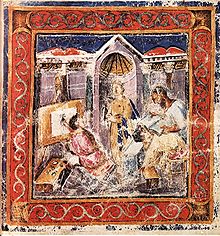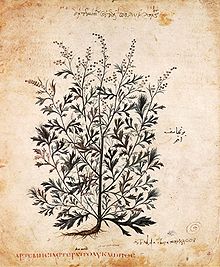Late antique book illumination
Only a small number of works of late antique illumination have survived. Only a few original examples have survived, especially from pre-Roman times.
Author portraits


An independent genre of antique book illustration is the author's portrait that precedes the text. Alone are the regular collections of portraits of great spirits, which, as the older Pliny reports, the great Roman scholar Varro (116-27 BC) is said to have spread in his writings.
Scientific and didactic texts
Illustrations inside the scroll or codex can be part of the text intended by the author or added later. For pre-Roman antiquity only illustrations are attested in scientific or didactic texts. They were either integrated into the running text or attached to it - at the end of the roll. Most of the time the illustrations have not been preserved in the handwritten records. But they can be made accessible because the text refers to them. This applies e.g. B. for geometric constructions in the writings of Plato and Aristotle . The illustrations in Euclid's mathematical work have been handed down by hand (around 300 BC; oldest surviving manuscript from the 10th century AD in the Vatican ). The oldest extant antique papyrus with explanatory illustrations comes from the 2nd century BC. Chr. (In the Louvre ); it is the excerpt from an astronomical treatise by Eudoxus , a contemporary of Plato.
Simple line drawings are sufficient for geometric constructions and schematic explanations; on the other hand, botanical or zoological writings, for example, can be provided with elaborate painting . Pliny the Elder mentions that around 100 BC At the court of the Pontic king Mithridates VI. living pharmacologist Krateuas , who created a herbal book with colored illustrations; Pliny also points out the danger of falsification that exists when copying the images. Insofar as colored pictures of plants on papyrus have survived, they come from a later period. A herbal book also contains the only extensively preserved and fully illustrated book of antiquity, the so-called Wiener Dioskurides (Austrian National Library in Vienna). The military doctor Dioskourides wrote the pharmacological work around 68 AD. The creation of the Vienna Codex is dated around 512. Since the text does not go into the illustrations, these were probably not intended by the author. Another copy of the work (from the 7th century) is kept in Naples.
Literary texts
The few remaining illustrations of literary Greek papyri are limited to the genres of the so-called New Comedy (see Comedy ) and the novel. All of the manuscripts date from Roman times. The illustrations usually show only a few people in the action.
Role style
The illustrations of the mentioned scientific-didactic and literary text genres show the typical 'role style'. This form of book illustration was created as a design tool for the scroll and was later incorporated into the code. The illustrations are inserted into the text columns without a frame. Even if they are colored, figures remain outline drawings of not particularly high quality. A spatial and scenic environment is not reproduced.
Narrative codex illustrations of late antiquity

The narrative ('narrative') codex illustrations of late antiquity (4th – 6th centuries AD ) form an independent tradition . They are limited to Greek and Latin epic literature, that is, to Homer and Virgil , as well as biblical texts: e.g. B. the Ilias Ambrosiana ( Milan ), the Vergilius Vaticanus (Vatican), the Quedlinburger Itala ( Berlin State Library ). In no case the illustration was intended by the author. The late antique illustrations are either interspersed with the text at irregular intervals or arranged regularly (e.g. on the lower half of the page). Occasionally they are also grouped together. As a rule, they have a fixed framework. The figures move in a landscape or architectural setting. They are full-bodied, that is to say three-dimensionally, with detailed coloring. Slight deviations from the rule (e.g. lack of frames) show some illustrated codices whose parchment pages are colored purple like those of the Vienna Genesis ( Austrian National Library , Vienna). Various researchers suspect that the narrative codex illustrations of late antiquity go back to Hellenistic picture scrolls. The existence of such picture scrolls remains hypothetical.
See also
- Major works of late antique illumination
- illustration
- Ancient libraries
- Papyrus , papyrology
- Loss of books in late antiquity
literature
- Horst Blanck : The book in antiquity. Beck, Munich 1992, ISBN 3-406-36686-4 , ( Beck's archaeological library ). (Extended: Ders .: Il libro nel mondo antico . Edizione revista e aggiornata a cura di Rosa Otranto. Pref. Di Luciano Canfora. Ed. Dedalo, Bari 2008, ISBN 978-88-220-5814-0 , ( Paradosis 15) ).
- Hubert Cancik and Helmuth Schneider (eds.): The new Pauly . Encyclopedia of Antiquity. Vol. 2. Metzler, Stuttgart a. Weimar 1997, ISBN 3-476-01472-X , various articles.
- Severin Corsten / Günther Pflug / Friedrich Adolf Schmidt-Künsemüller (ed.): Lexicon of the entire book system. 2nd completely revised edition. Hiersemann, Stuttgart 1987, ISBN 3-7772-8721-0 , vol. 1.
- Angelika Geyer : The Genesis of Narrative Book Illustration. The miniature cycle on the Aeneid in Vergilius Vaticanus . Klostermann, Frankfurt am Main 1989, ISBN 3-465-01888-5 , ( Frankfurt scientific contributions. Cultural studies series 17) (At the same time: Regensburg, Univ., Habil.-Schr., 1988).
- Herbert L. Keßler: Studies in Pictorial Narrative. Pindar Press, London 1994, ISBN 0-907132-77-4 .
- Stavros Lazaris: "L'image paradigmatique: des Schémas anatomiques d'Aristote au De materia medica de Dioscoride", Pallas, 93 (2013), p. 131–164 http://www.academia.edu/10055661/L_image_paradigmatique_des_Sch%C3%A9mas_anatomiques_d_Aristote_au_De_materia_medica_de_Dioscoride
- Otto Mazal : Greco-Roman Antiquity . Akademische Druck- und Verlagsanstalt, Graz 1999, ISBN 3-201-01716-7 ( History of Book Culture 1).
- Alfred Stückelberger : pictures and words. The illustrated textbook in ancient science, medicine and technology . von Zabern, Mainz 1994, ISBN 3-8053-1698-4 , ( Cultural History of the Ancient World 62), ISSN 0937-9746 .
- Kurt Weitzmann : Ancient Book Illumination . Harvard University Press, Cambridge, Mass. 1959 ( Martin classical lectures 16), ISSN 0076-471X .
- Kurt Weitzmann: Illustrations in Roll and Codex. A Study of the Origin and the Method of Text Illustration . 2. print., With addenda. University Press, Princeton NJ 1970, ISBN 0-691-03865-1 , ( Studies in manuscript illumination 2).
- Kurt Weitzmann: Late Antiquity and Early Christian Illumination . Prestel, Munich 1977, ISBN 3-7913-0401-1 , ( The great manuscripts of the world ), (Original edition: Late antique and early Christian book illumination Braziller, New York NY 1977, ISBN 0-8076-0831-9 ).
- David H. Wright: The Vergilius Vaticanus. A masterpiece of late antique art. Academic Printing and Publishing Company, Graz 1993, ISBN 3-201-01584-9 .
